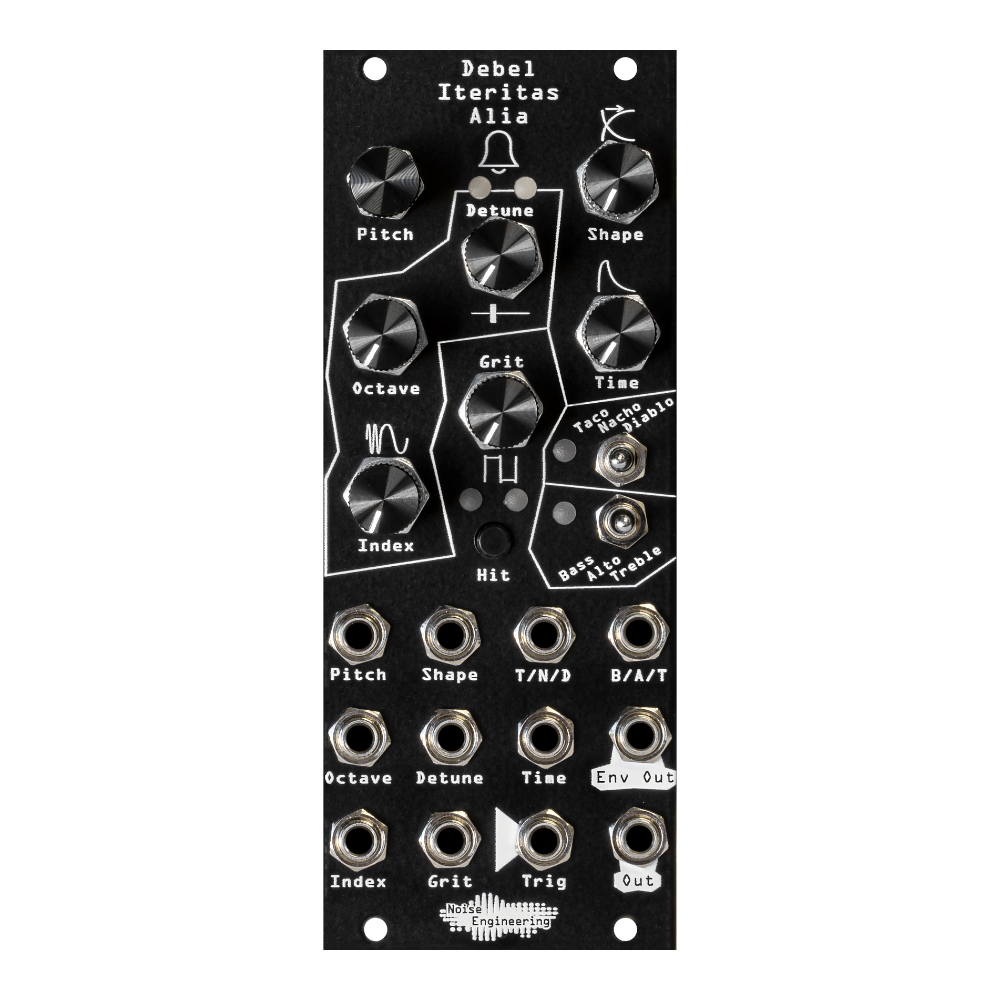Introducing Debel Iteritas Alia
Last week, we announced the Alia line, bringing back Basimilus and Manis, and introducing the entirely new Debel. In our previous blog, we chatted about the general concept and history of the platform. Over the next few weeks, we’ll chat in-depth about each firmware.
So, Debel: let’s taco ‘bout it.
Debel: it lives up to its name
When we finished developing the Alia hardware, we knew we wanted to bring completely new things to the series. It’s been a while since we released a new oscillator, and we knew we wanted this one to explore a different set of synthesis techniques.
At our last annual meeting, affectionately named Synthdaddi, we discovered an extremely cool factory DX7 patch. We fell in love. Many tubular-bell-esque jams were had. A good time was had by all.
Flash forward: Stephen shared a new firmware with the team. The core functionality of the firmware was inspired by the structure of that preset, but it was based around phase modulation and added… well, an additive structure to the operators. We borrowed the envelope from the Percido series, added some distortion (because of course we did), worked out a few different algorithms, and ate some tacos.
The development of Debel wasn’t all fun and games, though: we started working on Debel after the hardware for Alia had been “finalized.” In what can only be described as a combo meal of terrible luck and unfortunate surprises, the Debel firmware unveiled some otherwise-subtle hardware issues with how the CPU was drawing power that the other firmwares hadn’t run into.
A panicked weekend of hardware modification and last-minute changes ensued, but we were able to fix the issue without too many part updates, and Debel was finished without further incident.

Debel is a very different voice for us: we have a reputation for hard-hitting and gnarly timbres, but we wanted to show off the sensitive side of PM. Debel can be gnarly if you want it to, but it excels at bells, soft plucks, and it can be downright beautiful if you want it to.
What is phase modulation and why do you need it in your (Euro)rack?
Phase modulation is a synthesis technique that uses audio-rate modulation to create different sounds. Slow modulation is usually quite noticeable: think about an LFO modulating a filter, for example. But when modulation happens at audio rates, the result sounds more like a new, distinct timbre instead of a slow change. When an oscillator’s phase is modulated at audio rates, the resulting timbre is often bright and metallic. PM is often used for synthesizing metallic sounds like bells, hence the inspiration for this firmware.
If you’re familiar with FM synthesis, PM will often sound quite similar. When comparing FM and PM in a digital environment, the way that the sounds are calculated and generated is quite different, but the results are often nearly identical.
Additive PM made easy
Phase-modulation synthesizers tend to be complicated to work with. Often, you’re left managing the frequency ratios and modulation routings manually, which can be time consuming and lead to unexpected results. The same is true for additive synthesizers: it’s a fantastic way of creating sounds, but it can also be quite time consuming and complicated.
Despite the complexity, PM is one of our favorite techniques ever: the sonic potential is vast, and some of our favorite sounds of all time are based around PM. We wanted Debel to be easy to manage and fun to jam with, so we spent a lot of time fine-tuning the controls to make sure they address the most important aspects of the core algorithm in a predictable and useful way. One parameter controls the additive oscillator balance, one controls modulation amount, and one controls operator tuning. The Taco/Nacho/Diablo switch changes the modulation structure to one of three options. That’s it!
This simple structure means it’s easy to go from a big FM-style pluck to a distorted lead to an ambient texture. We also expanded the envelope times: Manis and Basimilus were both designed with percussive, impactful sounds in mind. And while Debel can make some pretty epic impacts and hits, it can also make long, drawn-out sounds perfect for an ambient background, even though the controls have a somewhat familiar feel if you know the BIA.
All that complicated PM stuff under the hood? It’s nacho problem.
Take a listen
If you’re interested in a Debel, there’s no better way to get to know it than hearing what it can do. POB, as usual, did a fantastic job going through some sounds and controls in the official manual video.
We’ve also documented some of our favorite Debel patches in the user manual, along with the usual control definitions and some more history of the module’s (surprisingly eventful) development.
Of course, since Alia is a platform, if you buy one, you get them all. Manis, Basimilus, and Debel firmwares are currently available (with more on the way). Alia are shipping now so you can learn more at the World of Alia and order yours at your local retailer or our webshop.





